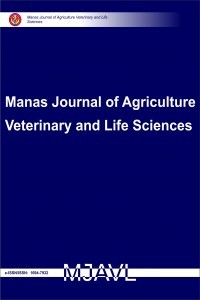Devamlı Aydınlık ve Devamlı Karanlığın Achroia grisella (Lepidoptera: Pyralidae)’da Değişik Yaştaki Erginlerin Total Lipit Miktarına Etkisi
Achroia grisella (küçük kovan güvesi) arıcılıkta peteklere zarar veren bir türdür. Bu türün larvaları kovanlarda ciddi zararlara yol açarlar. Bu böcekle yapılacak mücadelede ve laboratuvar çalışmalarında biyolojik özelliklerinin bilinmesi önemlidir. Fotoperiyot canlılarda birçok metabolik ve fizyolojik faaliyeti etkiler. Bu çalışmada, devamlı aydınlık (DA) ve devamlı karanlığın (DK) farklı yaşlardaki A. grisella (küçük kovan güvesi) erginlerinin total lipit miktarına etkisi araştırıldı. Denemeler 28 ± 2 °C ve % 65 ± 5 nisbi nem içeren laboratuvar şartlarında yapıldı. Analizler için stoklanan örneklerdeki total lipit miktarının belirlenmesinde Van Handel [16]’in geliştirmiş olduğu yöntem esas alındı. Farklı fotoperiyot rejimleri 40 wattlık floresans ampullerle sağlandı. Her iki fotoperiyot rejiminde 100 mg ergindeki lipit miktarı her iki eşeyde de yaşla birlikte azalma gösterdi. Her iki fotoperiyot rejiminde yetiştirilen erginlerde dişilerin total olarak erkeklerden daha fazla lipit içerdiği tespit edildi
Anahtar Kelimeler:
Achroia grisella, fotoperiyot, total lipit miktarı, ergin yaşı
Effects of Continuous Ligth and Darkness on the Total Lipid Amounts of Achroia grisella (Lepidoptera: Pyralidae)’s Different Ages Adults
Achroia grisella is a harmful species for combs and it’s larvae are known as causing serious damages in beekeeping. It is important to know the biological characteristics of this insect for biological control and laboratory studies. Photoperiod affects many metabolic and physiological activities of organisms. In this study, were investigated the effect on the amount of total lipid in continuous light and continuous darkness in A. grisella that different age. Studies were carried out under the laboratory conditions at 28 ± 2 ° C temperature and 65 % ± 5 relative humidity. Illumination was done with 40 W fluorescent bulbs in different photoperiod regimes. Calculating the amount of lipids for analysis, van Handel (1985) test was used. Both females and males, the amounts of lipids decreased as the adult aging. Results from this study is show that increase of dark period, caused decrease amounts of lipids. The amount of lipid in females is more than those observed for males
Keywords:
Achroia grisella, photoperiod, total lipid amount, adult age,
___
- [1] Hodkova, M., Berkova, P. & Zahradrickova, H. (2002) Photoperiodic Regulation of the Phospholipid Molecular Species Composition in Thoracic Muscles and Fat Body of Pyrrhocoris apterus (Heteroptera) Via an Endocrine Gland, Corpus Allatum. Journal of Insect Physiology, 48(11): 1009-1019.
- [2] Morita, A., Soga, K., Hoson, T., Kamisaka, S. & Numata, H. (1999) Changes in Mechanical Properties of the Cuticle and Lipid Accumulation in Relation to Adult Diapause in the Bean Bug, Riptortus clavatus. Journal of Insect Physiology, 45, 3, 241-247.
- [3] Shuxia, Y. & Adams, T.S. (2000) Effect of Pyriproxyfen and Photoperiod on Free Amino acid Concentrations and Proteins in the Hemolymph of Colorado Patato Beetle, Leptinotarsa decemlineata. Journal of Insect Physiology, 46, 10, 1341-1353.
- [4] Walton, J.C., Weil, Z.W. & Nelson, R.J. (2011) The influence of photoperiod on behavior, endocrine, and immune function. Frontiers in Neuroendocrinology, 32, 302-319.
- [5] Giron, D. & Casas, J. (2003) Lipogenesis in Adult Parasitic Wasp. Journal of Insect Physiology, 49, 141-147.
- [6] Kumar, D., Misiura, A. & Singn, A.K. (2004) Stage and Sex Dependent Changes in the Lipid Profile of Psyderrous koenigii (Heteroptera: Pyrrhocoridae) During Development. International Journal of Tropical Insect Science, 24, 3, 236-241.
- [7] Warburg, M.S. & Yuval, B. (1996) Effects of Diet and Activity on lipid levels of adult mediterranean fruit flies. Physiological Entomology, 21, 151-158.
- [8] Akbay, R. (1985) Arı ve İpekböceği Yetiştirme. A.Ü. Ziraat Fakültesi Ders Notu, Ankara, 122 s.
- [9] Collins, R.D., Jang, Y., Reinhold, K. & Greenfield, M.D. (2000) Quantitative Genetics of Ultrasonic Advertisement Signalling in the Lesser Waxmoth, Achroia grisella (Lepidoptera:Pyralidae). Heredity, 84,73-80.
- [10] Nurullahoğlu, Z.U. (2003) Achroia grisella (Lepidoptera: Pyralidae) Larva ve Pupunun Yağ Asidi Bileşimi. Selçuk Üniversitesi, Fen –Edebiyat Fakültesi Fen Dergisi, 2, 75-78.
- [11] van Handel, E. (1985) Rapid Determination of Total Lipids in Mosguitoes. Journal of the American Mosquito Control Association, 1, 302-304.
- [12] Chocorosgui, V.R. & Panizzi, A.R. (2003) Photoperiod Influence on the Biology and Phenological Characteristics of Dichelops melacanthus (Heteroptera: Pentatomidae). Brazilian Journal of Biology, 6, 4, 655-664.
- [13] El-Aw, M.A. (2003) Effect of Host Plant, Photoperiod, Day Time, Developmental Stage and Sex on Protein Patterns and Esterase Inhibition Heads of the Cotton Leafworm Spodoptera littoralis (Lepidoptera: Noctuidae). Journal of Agricultural Research, 48,1, 89-52.
- [14] Moribayashi, A., Kurahashi, H., Sugie, H., Katagiri, C. & Tsuchida, K. (2003) Lipids and Ecdysteroids on the Ovarian Growth of the Adult Blow Fly, Aldrichina grahami. The Japan Society of Medical Entomology and Zoology, 54, 1, 65-71.
- [15] Rockstein, M., & Miguel, J. (1974) Aging in Insect in ‘ Physiology of Insecta’, Second Edition, Academic Press, New York, 478 pp.
- [16] Zera, A., Mole, S., & Rokke, K. (1994) Lipid, Carbohydrate and Nitrojen Content of Long and Short Winged Gryllus firmus: Implications for the Physiological Cost of Flight Capability. Journal of Insect Physiology, 40, 1037-1044.
- [17] Jacome, I., Aluja, M., Liedo, P. & Netsel, D. (1995) The Influence of Adult Diet and Age on Lipid Reserves in the Tropical Fruit Fly Anastrepha serpentina (Diptera: Tephritidae). Journal of Insect Physiology, 41, 12, 1079-1086.
- [18] Bailey, E. (1975) Biochemistry of Insect Flight. In ‘ Insect Biochemistry and Function’, Chapman and Hall, London, 282 pp.
- [17] Watanabe, M. (2000) Photoperiodic Control of Development and Reproductive Diapause in the Leaf Beetle Ophraella communa LeSage. Entomological Science, 3, 2, 245-253.
- [20] Niva, C.C. & Takeda, M. (2003) Effects of Photoperiod, Temperature and Melatonin on Nymphal Development, Polypherism and Reproduction in Halyomorpha halys (Heteroptera: Pentatomidae). Zoological Science, 20, 8, 963-970.
- ISSN: 1694-7932
- Yayın Aralığı: Yılda 2 Sayı
- Başlangıç: 2013
- Yayıncı: KIRGIZİSTAN-TÜRKİYE MANAS ÜNİVERSİTESİ
